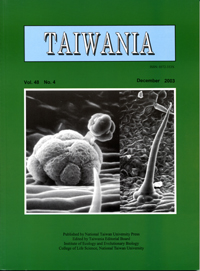Research Paper
Anther and Pollen Wall Development in Dumasia miaoliensis Liu and Lu (Fabaceae)
Chia-Chin Liu and Tseng-Chieng Huang
Published on: December 2003
Page: 273 - 281
DOI: 10.6165/tai.2003.48(4).273
Abstract
This paper is intended for elucidation the anther and pollen wall development of Dumasia miaoliensis Liu and Lu (Fabaceae). The undifferentiated anther is ovoid-shaped and tetrasporangiated. The anther wall development is basic type, which is composed of an epidermal layer, an endothecial layer, two middle layers and tapetum. Anther-tapetum is glandular type and its’ cells are uniseriate and uninucleate. Pollen grains are 6-porate and 2-celled at the time of shedding. Before protectum development, a glycocalyx layer is deposited on the invaginated plasma membrane, exclusive of the future apertures. Subsequently, the probacules, arising basally from the plasma membrane, elongate under the protectum. The foot layer and endexine formation are concomitant with the callosic wall dissolution. The foot layer is thin and interrupted, but the endexine is thick and continuous. The intine is initiated in the vacuolated stage.
中文摘要
未分化的苗栗野豇豆花藥是卵形具有四個小孢子囊,花藥壁是由一層表皮、一層花 藥內壁、兩層中間層及一層營養層所構成,是屬於基本型。營養層為分泌型,由單核的單層細胞組成。花粉粒具六孔,釋出時為兩個細胞時期。花粉壁在原蓋頂層發育前,除了未來發芽孔外,細胞膜向內凹陷。接著,位於原蓋頂層下方之臘梅糖和原柱狀層從細胞膜向基開始延長生長。底層及花粉外壁內層形成伴隨著胼祇質瓦解。底層很薄且呈不連續狀,花粉外壁內層很厚且呈連續狀。花粉內層起始於液胞化時期。
Keyword: Callose, Dumasia miaoliensis, Fabaceae, Probacule, Protectum


